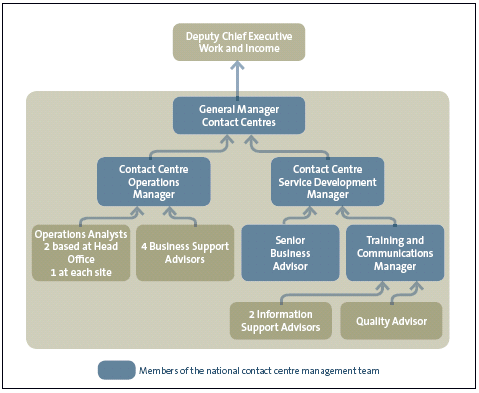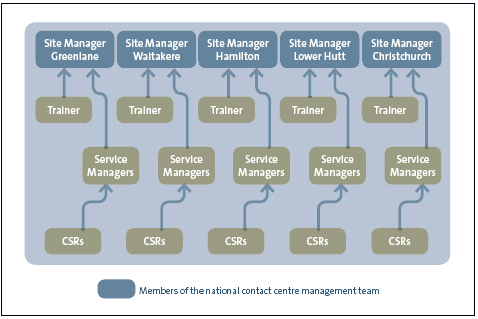Part 1: Introduction
1.1
In this Part, we set out:
- why we undertook this performance audit;
- the objectives of our audit; and
- how we conducted our audit.
1.2
We also describe the purpose, work, and structure of the contact centre we audited.
Why we undertook this performance audit
1.3
Local authorities and central government agencies have been operating contact centres1 for some time, and the range of services provided through contact centres is continuing to grow. We have looked at contact centre operations in the past, but only as part of wider performance audits.2 It was timely to recognise the growing role of contact centres in the delivery of public services.
1.4
Within the Ministry of Social Development (the Ministry), the performance of the Work and Income contact centre (the contact centre) is critical to the efficient and effective delivery of income support and work assistance to large numbers of people. Its role is also evolving rapidly as it works alongside Work and Income service centres to implement government initiatives such as the Working for Families package and programmes to help job seekers. Its importance as part of Work and Income, and as part of the Ministry, led us to choose it for this performance audit.
Objectives of our audit
1.5
Our audit sought to assess and report on the contact centre’s contribution to Work and Income’s service delivery outcomes.
1.6
The three broad objectives of our performance audit were to assess:
- whether the contact centre follows recognised best practice;3
- the management systems used to support the contact centre; and
- the relationships between the contact centre and the rest of Work and Income.
How we conducted our audit
1.7
There is a large body of literature about contact centre practice4, including reports published by other audit offices. We assessed the performance of the contact centre against recognised good practice for contact centres and against its own standards. In planning the audit, we also talked to selected contact centre managers about best contact centre practice, and consulted Work and Income on our performance criteria.
1.8
We examined how the contact centre manages its relationship with clients – people who receive state-funded income assistance (for example, a benefit or New Zealand Superannuation). We also examined its systems for managing staff, controlling quality, and supporting operations. We interviewed a variety of Work and Income staff to find out how these systems worked and to confirm that they were followed in practice.
1.9
Work and Income employs about 4755 customer service representatives (CSRs)6, who work at five sites in Christchurch, Lower Hutt, Hamilton, Greenlane, and Waitakere. The five sites operate as a “virtual” contact centre. Incoming calls are directed to the next available CSR no matter where the call was made or where the CSR is located. Our fieldwork included visits to two contact centre sites – Lower Hutt and Waitakere – where we talked to CSRs and managers about their work. We also visited four Work and Income service centres to find out how they viewed their relationships with the contact centre.
1.10
The role of the contact centre is evolving in response to changes in the way Work and Income delivers its services. These changes have required the contact centre to amend its practices, and required careful planning. To assess how this planning was carried out, we looked at how the contact centre prepared to participate in two particular projects:
- the introduction of the New Service Model (assessing all clients for work readiness and supporting those who are able to enter the workforce); and
- outbound calling.7
1.11
We examined project documentation and talked to contact centre and other Work and Income staff about aspects of planning for these changes and their effect on the contact centre.
1.12
We did not examine:
- the service individual clients receive from Work and Income; or
- Work and Income’s policies or practices on benefits or employment assistance.
Work and Income and its contact centre
1.13
Work and Income’s main tasks are to assist job seekers and beneficiaries, and pay income support on behalf of the Government.
1.14
Work and Income has a network of service centres where clients meet face to face with case managers. Work and Income also operates a contact centre that callers access by calling any one of a number of Work and Income 0800 (free for the caller) telephone numbers. The contact centre does not deal with e-mails or facsimile messages from clients, except for those received through the Deaf Link free facsimile line for the hearing impaired.
1.15
The contact centre deals with a wide range of enquiries about benefits and work. CSRs tell callers about the services administered by Work and Income, change client records, record verbal applications for benefits or other assistance, make appointments for clients at their local service centre, and arrange attendance at workshops for job seekers.
1.16
Receiving about 100,000 telephone calls every week, the contact centre is one of New Zealand’s busiest. The number of calls handled by the contact centre has grown from about 4.3 million in 1997/98, its first full year of operation, to almost 6 million in 2005/06. The contact centre’s operating budget for the 2005/06 financial year was $29.6 million.
1.17
More than 80% of calls to the contact centre come through Work and Income’s General Enquiries telephone number. The contact centre also answers calls to several other 0800 numbers, such as one for calls about New Zealand Superannuation and one for employers looking for workers. There are also different telephone lines for 11 different languages. The contact centre operates Service Express, a telephone system where clients can advise Work and Income about changes of income and other details without speaking to a CSR.
1.18
Outbound calling is becoming an increasingly important part of the contact centre’s work. Work and Income introduced outbound calling in October 2004 to inform the public about the Working for Families package. Since then, the contact centre has undertaken a number of other outbound calling campaigns directed at different groups of clients.
Roles and structure
1.19
Responsibility for managing the contact centre is divided between a small national operations team, based in a national office, and managers at the five sites. The contact centre as a whole is overseen by the General Manager Contact Centres, who is a member of the Work and Income Executive and reports to the Deputy Chief Executive Work and Income.
1.20
The national operations team also includes the Operations Manager, the Service Development Manager, and the Training and Communications Manager. These managers are supported by several advisors and analysts.
1.21
The national operations team oversees call volume forecasting, workforce scheduling, rostering, outbound campaigns, training, industrial relations, and quality control.
1.22
Figures 1 and 2 show the structure of the contact centre’s national office and the structure of the contact centre sites.
Figure 1 The organisational structure of the contact centre’s national office

Figure 2 The organisational structure of the contact centre sites

1.23
Each contact centre site has a site manager, who reports to the General Manager Contact Centres. Each site manager is supported by a team of service managers, who are each responsible for a team of between 15 and 20 CSRs. Each site also has an operations analyst (who reports to the contact centre’s Operations Manager) and a trainer. The manager of each site is a member of the contact centre management team, which meets each month.
1.24
The site managers are responsible for staffing each of the five sites (recruiting, training and coaching, reviewing performance, and maintaining quality).
1.25
The Ministry funds and manages most capital investment required by the contact centre, such as buildings and new technology. The Work and Income Executive directs policy changes and strategic development, such as introducing the New Service Model.
1: Contact centres are also known as call centres.
2: Towards Service Excellence: The Responsiveness of Government Agencies to their Clients, September 1999; Ministry of Justice: Performance of the Collections Unit in Collecting and Enforcing Fines, July 2005.
3: For example, timely client access to phone services, accurate and consistent advice and processing, a high standard of phone service, controls on quality, and efficient use of resources.
4: Two useful texts are Call Center Management on Fast Forward by Brad Cleveland and Julia Mayben, Call Center Press, Maryland US, 1997, ISBN 0-9659093-0-1, and The Complete Guide to Call and Contact Centre Management by Catriona Wallace and Johanna Hetherington, Pearson Education Australia, NSW Australia, 2003, ISBN 174009- 724-6.
5: Average number of full-time equivalent CSRs throughout the year.
6: The Work and Income staff responsible for handling calls to the contact centre.
7: Outbound calling involves CSRs making rather than receiving calls.
page top
